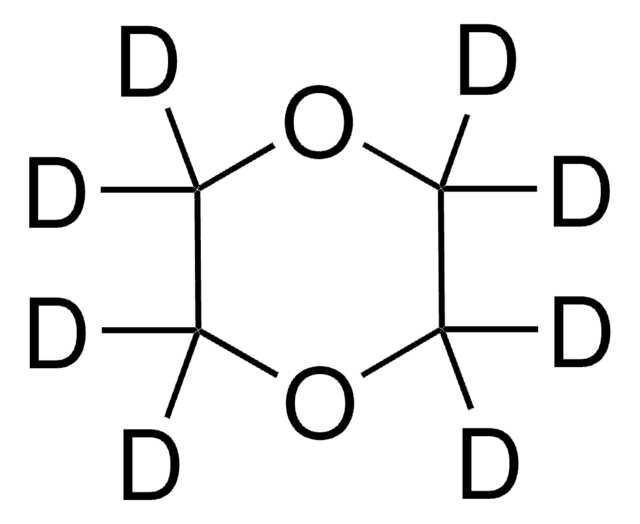34857
1,4-Dioxane
suitable for HPLC, ≥99.5%
Synonym(s):
Diethylene oxide, Dioxane
About This Item
Recommended Products
vapor density
3 (vs air)
vapor pressure
27 mmHg ( 20 °C)
40 mmHg ( 25 °C)
Assay
≥99.5%
form
liquid
autoignition temp.
356 °F
expl. lim.
22 %
technique(s)
HPLC: suitable
impurities
≤0.001% non-volatile matter
≤0.002% free acid (as CH3COOH)
≤0.01% peroxides (as H2O2)
≤0.05% water (Karl Fischer)
transmittance
220 nm, ≥20%
270 nm, ≥80%
300 nm, ≥98%
refractive index
n20/D 1.422 (lit.)
pH
6.0-8 (20 °C, 500 g/L)
bp
100-102 °C (lit.)
mp
10-12 °C (lit.)
density
1.034 g/mL at 25 °C (lit.)
UV absorption
λ: 220 nm Amax: ≤0.70
λ: 235 nm Amax: ≤0.50
λ: 250 nm Amax: ≤0.20
λ: 270 nm Amax: ≤0.10
λ: 295-400 nm Amax: ≤0.01
application(s)
food and beverages
SMILES string
C1COCCO1
InChI
1S/C4H8O2/c1-2-6-4-3-5-1/h1-4H2
InChI key
RYHBNJHYFVUHQT-UHFFFAOYSA-N
Looking for similar products? Visit Product Comparison Guide
Related Categories
General description
Application
- HPLC
- Spectrophotometry
- Residual testing
- LC-MS applications.
Reported as a solvent in:
- HPLC-MS study of fat-soluble vitamins (FSVs)
- GC-MS analysis of phthalates in workplace air
Signal Word
Danger
Hazard Statements
Precautionary Statements
Hazard Classifications
Carc. 1B - Eye Irrit. 2 - Flam. Liq. 2 - STOT SE 3
Target Organs
Respiratory system
Supplementary Hazards
Storage Class Code
3 - Flammable liquids
WGK
WGK 3
Flash Point(F)
51.8 °F - closed cup
Flash Point(C)
11 °C - closed cup
Certificates of Analysis (COA)
Search for Certificates of Analysis (COA) by entering the products Lot/Batch Number. Lot and Batch Numbers can be found on a product’s label following the words ‘Lot’ or ‘Batch’.
Already Own This Product?
Find documentation for the products that you have recently purchased in the Document Library.
Our team of scientists has experience in all areas of research including Life Science, Material Science, Chemical Synthesis, Chromatography, Analytical and many others.
Contact Technical Service




